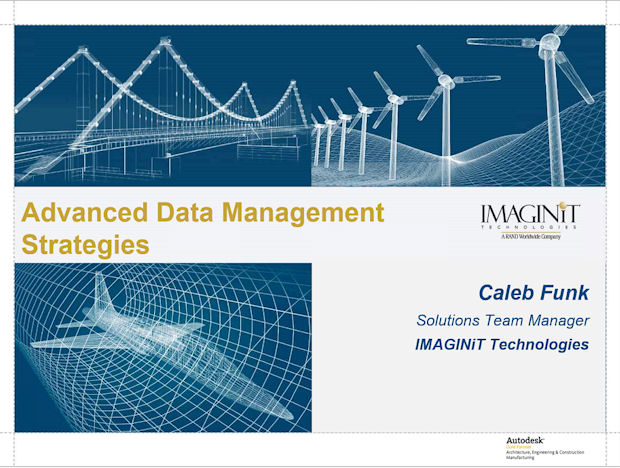Building a Successful PDM/PLM Strategy
Latest News
April 3, 2014
 Dear Desktop Engineering Reader:
Dear Desktop Engineering Reader:
I’ve watched today’s Check it Out on-demand broadcast “Building a Successful PDM/PLM Strategy” a number of times in preparation for this column. It’s an engrossing presentation for two reasons. One, it is a broad overview of the expertise that IMAGINiT Technologies can bring to a manufacturer looking to modernize or commit for the first time to a PDM (product data management) and/or PLM (product lifecycle management) infrastructure. Two, it is a well executed and an extraordinarily calm clearing away of much of the smoke and mirrors that surround these systems due to marketing and media exuberance. The point of it all is that better data management through a well-designed and well-implemented PDM/PLM strategy can profoundly affect your decision-making, design and manufacturing processes.
This 45-minute webinar covers a tremendous amount of ground. It begins with a look at data management, which makes sense since, at their core, PDM/PLM suites are data and document managers. The presenter, a guy named Caleb Funk, a Manufacturing Solutions team manager for IMAGINiT, says that data management is a top issue with the manufacturers he meets. But subsumed within worries about “data management” are broader concerns about process, workflow and productivity.
The basic idea here is you generate tons of data every step along the way from concept to development. But what kind of data is it? Who uses it? How do you access your data? The answer to the first question, of course, is that data is all kinds of stuff: sketches, design models, specifications, quality docs, technical documents, CAM toolpaths, bills of materials, process plans, schematics and so on.
Still, that doesn’t quite do the concept justice because individual bits of data are complicated things. Take a 3D CAD assembly. You have relationships to maintain. You have the top-level assembly, which is made up of subassemblies. You have to manage and control those relationships. Subassemblies have their own subassemblies to manage and control. Then there are parts and drawings of everything, change orders and variants. And then you have relationships to analysis files, quality, renderings and all sorts of things.
And everybody uses the data. People are constantly generating, consuming, collaborating, sharing, deleting, revising, making ads, purchasing things and doing whatever with data. This all leads to: How does everyone get at data, and how do you control it, manage revisions and so on?
With that table set, Funk then poses a deceptively simple question: How much of a single work hour of yours is productive? Not how busy you are, but how productive are you?
Answering his own question, Funk reports that IMAGINiT has found that about 15 minutes of every hour is productive work in manufacturing today. The rest of the hour is spent on non-value-added tasks like trying to find the correct data, babysitting process routings to make sure the right materials get to the right people at the right time, waiting for approvals, dealing with broken file relationships and re-entering the same old data over and over again.
So how can you make employees more productive? Many companies implement new tools and hardware in an effort to make their employees faster. Not to denigrate the value of new faster hardware and easy-to-use software, but such implementations alone can be a misdirected effort akin the old saw “the floggings will continue until morale improves.” It’s often your process that’s killing productivity. Specifically, the number of steps and their duration in your process.
All this leads us back to the value of strong, modern PDM/PLM implementations and how IMAGINiT works to help you leverage PDM or PLM to increase productivity through streamlined processes that help you make full use of your data. This is a soft sell, presented in that understated manner engineers have that befuddles non-techno types. The issues and concerns raised earlier are addressed and potential solutions offered. The differences between PDM and PLM are explained so that even the CFO can get it, and generic system topologies and how they operate are outlined. Topics addressed range from best practices to return on investment.
It’s best to look at “Building a Successful PDM/PLM Strategy” as a deep and thorough backgrounder. It touches on every pain point, many of which you know well from reviewing how your processes operate. There’s just so much going on with “Building a Successful PDM/PLM Strategy” that it will pop up in your thoughts long after you return to the daily grind. Very well done. You can access this complimentary webinar from today’s Check it Out link.
Thanks, Pal. – Lockwood
Anthony J. Lockwood
Editor at Large, Desktop Engineering
Subscribe to our FREE magazine, FREE email newsletters or both!
Latest News
About the Author
Anthony J. Lockwood is Digital Engineering’s founding editor. He is now retired. Contact him via [email protected].
Follow DE






